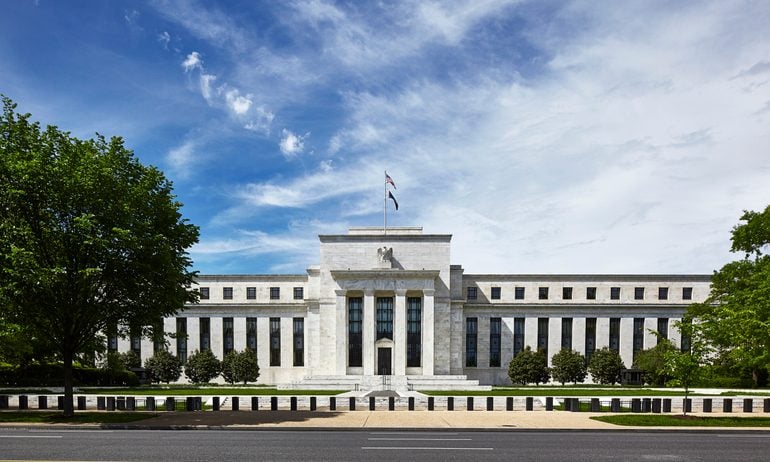What Is the Federal Reserve?
The Federal Reserve is the U.S. central bank whose rate changes can indirectly affect your bank’s savings and loan rates.

Many, or all, of the products featured on this page are from our advertising partners who compensate us when you take certain actions on our website or click to take an action on their website. However, this does not influence our evaluations. Our opinions are our own. Here is a list of our partners and here's how we make money.
Table of Contents
If you follow the news about changes to savings or mortgage rates, you’ve probably heard of the Federal Reserve. It’s a powerful financial system, but as a banking consumer, you don’t interact with it directly. Here’s what you need to know.
» Skip down to the current Fed rate
What is the Federal Reserve?
The Federal Reserve System — also known as the Federal Reserve or the Fed — is the central bank of the United States, which sets policies to keep the economy steady and controls the money supply, among other responsibilities. The word “system” is important for understanding that the Fed is not a single central bank like in many other countries. Instead, it consists of three main entities:
The Federal Reserve Board of Governors.
12 Federal Reserve Banks.
The Federal Open Market Committee.
For more details, skip down to “The Fed’s origins and structure” section.
What does the Federal Reserve do?
Overall the Fed performs five main functions:
Manages U.S. monetary policy, which refers to actions intended to achieve its macroeconomic goals such as stable prices and full employment.
Helps keep the financial system stable. This means that people and businesses can save and borrow money even when markets are volatile.
Supervises and regulates financial institutions, such as national and some state banks.
Provides banks certain services, such as payment and funds settlement systems.
Advocates for consumer protection and community development.
How the Federal Reserve affects you
Many of the Fed’s policies and actions impact the economy at large, such as controlling the money supply and providing transfers between banks. But when the Fed changes the federal funds rate, you might feel a more tangible impact: The interest rates on your savings accounts or loans may shift.
When is the next Fed meeting?
Does the Fed regulate cryptocurrency?
The Fed announced in early August 2023 that it will begin overseeing additional activities of the banks it supervises. The central bank will do this through its new novel activities supervision program, which will focus on strengthening oversight of banks’ activities relating to blockchain technology, cryptocurrency and tech-driven nonbank partnerships. The new program will become part of the Fed’s current supervisory practices, with "program experts working alongside current supervisory teams to oversee banks engaged in novel activities," according to the Fed's press release .
What is FedNow?
FedNow is the Fed’s instant payment service that launched in July 2023. All banks and credit unions can opt into using the service, but it’s not required. Consumers, however, must be at a bank or credit union that participates to take advantage of sending and receiving money within seconds, 24/7. For more details, see our FedNow explainer.
What is the Fed’s Bank Term Funding Program?
After two banks failed in mid-March 2023, the Federal Reserve created a new program to help prevent further crises. The Bank Term Funding Program aims to provide loans of up to one year to banks and credit unions, among others, that would pledge U.S. Treasuries and certain other assets as collateral. These loans would serve as an additional source of cash so that banks won’t need to sell off investments quickly the way Silicon Valley Bank did to accommodate panicked deposit customers.
What is the federal funds rate?
Definition
The Fed controls one rate — or to be more precise, the target range of a rate — called the federal funds rate. This is the interest rate that banks use when borrowing from each other overnight to meet short-term business requirements, such as having enough cash reserves to handle market conditions.
To keep the economy stable, the Fed typically either raises the Fed funds rate to curb inflation or lowers it to stimulate the economy. Banks tend to move their rates on consumer loans and savings accounts in the same direction as the Fed’s rate.
» Learn more: What Fed rate decisions mean for CDs
Who determines the rate?
The Federal Open Market Committee decides to raise, lower or leave unchanged the Fed funds rate during its meetings. There are eight meetings per year, and at each one, the FOMC discusses its stance on current and future economic conditions, which provides rationale for rate changes.
What is the current federal funds rate?
Here are the most recent Fed rates from FOMC meetings:
FOMC meeting dates | Rate change | Fed rate (as a target range) |
|---|---|---|
Dec. 9-10, 2025. | Decrease of 25 basis points (or 0.25 percentage point). | 3.50% - 3.75%. |
Oct. 28-29, 2025. | Decrease of 25 basis points. | 3.75% - 4.00%. |
Sept. 16-17, 2025. | Decrease of 25 basis points. | 4.00% - 4.25%. |
July 29-30, 2025. | None. | 4.25% - 4.50%. |
June 17-18, 2025. | None. | 4.25% - 4.50%. |
May 6-7, 2025. | None. | 4.25% - 4.50%. |
March 18-19, 2025. | None. | 4.25% - 4.50%. |
Jan. 28-29, 2025. | None. | 4.25% - 4.50%. |
Why does the Fed control a target range of the Fed rate?
The Fed doesn’t participate in the actual lending or borrowing between two banks, which leaves the borrowing rate up to any two banks negotiating. What the Fed does is motivate banks to borrow within a specified target range. The Fed changes three rates that impact how much a bank can earn in interest with the Fed and how much borrowing from the Fed costs. Raising the three rates raises the Fed funds rate, making borrowing more expensive, which ideally slows down the economy (and inflation). Lowering the three rates does the opposite, making borrowing cheaper.
How Fed rate changes impact you

For borrowers: When the Fed raises or lowers its rate, banks often change interest rates in the same direction on new loans and some existing loans that have variable rates, such as credit cards, home equity lines of credit and small business loans. A Fed rate change influences a bank’s prime rate, which is the minimum interest rate determined by individual banks on loans to high creditworthy customers. What the Fed publishes as the prime rate is based on rates at most of the 25 biggest banks.
» Learn more: How the Fed affects mortgage rates
For savers: Banks also change rates on regular savings accounts and certificates of deposit in the same direction as a Fed rate change. Rate decreases mean less appealing savings rates, while rate increases can attract more savers, allowing a bank to use more deposits to fund loans. In practice, the biggest banks rarely raise savings rates, while smaller or online-only institutions often do. The best high-yield online savings accounts and the best CD rates are around 4% annual percentage yield.
The Fed’s origins and structure
Congress established the Federal Reserve System through a 1913 law to bring more stability to America’s financial system. At that time, the U.S. was reeling from a series of financial crises that culminated in the panic of 1907. Congress oversees the Federal Reserve through audits and testimony, but all decisions that the Fed makes are independent. The Fed operates through its three entities:
Board of Governors
The Federal Reserve Board of Governors is a centralized authority based in Washington, D.C., that oversees the decentralized network of 12 Federal Reserve Banks as well as the general goals of the Fed. There are normally seven members called governors whom the U.S. president nominates and the Senate confirms.
Reserve Banks
The Reserve Banks serve as regulators of various financial institutions, lenders of last resort for banks that lack enough money in reserves, and operators of U.S. payments for both Automated Clearing House and wire transfers. The Reserve Banks also act as the government’s bank by maintaining the U.S. Treasury’s account for processing payments and other operations.
There is a Reserve Bank in 12 U.S. cities: Boston; New York; Philadelphia; Cleveland; Richmond, Virginia; Atlanta; Chicago; St. Louis; Minneapolis; Kansas City, Missouri; Dallas and San Francisco. Each Reserve Bank’s district boundaries correspond to trade routes from 1913, with some modifications over time. Their regional differences can help inform the Fed’s policymaking.
Federal Open Market Committee
The FOMC sets monetary policy, such as by changing the Fed funds rate, to promote stable prices and growth in the economy, including maximum employment. Seven members from the Board of Governors and five Federal Reserve Bank presidents form the FOMC.
The Fed’s role in inflation
The FOMC hopes to achieve an inflation rate of 2% over a long-term period as a way to keep the economy steady. The Fed’s primary tool for influencing inflation is making changes to the federal funds rate, though global economic conditions can complicate the Fed’s impact.
Inflation, or the rate that the costs of goods and services increase, can be a sign of a growing economy and also cause hardships for many Americans. The Fed believes that people and businesses can make informed decisions on borrowing, saving and investing when inflation is stable and relatively low.
The Fed’s role in consumer protection
Federal Reserve Banks ensure that banks in their districts abide by all regulations, including the Community Reinvestment Act, a 1977 law that expects banks to meet the credit needs where the bank does business, including low- and moderate-income households.
Congress also passed a landmark law in 2010, the Dodd-Frank Act, that expanded the Fed’s system by creating the Consumer Financial Protection Bureau as an independent agency. The CFPB enforces laws and enacts rules and policies to promote a fair and transparent marketplace for consumer financial services, and can be an advocate for anyone who needs to dispute credit report errors or file a complaint against their bank.
Monetary policy tools
The Fed has changed its tools over time, especially during and after the Great Recession of 2007 to 2009 and the COVID-19 pandemic. Here’s an overview:
Open market operations refer to the FOMC buying or selling U.S. government securities, such as Treasury bonds, in the open market. Historically, this tool was the main way the Fed changed the federal funds rate, but that changed during the pandemic. The Fed now uses these operations to keep the supply of overnight reserves plentiful.
These three tools are rates the Fed controls that move in the same direction as the Fed funds rate and guide it. The first two relate to what financial institutions can do with the cash they want to keep accessible for short-term needs; the third is for banks that need more cash.
Interest on reserves is the interest rate banks receive on cash in their accounts at their region’s Federal Reserve Bank. The rate is the primary tool for moving the federal funds rate. Since banks want a return on their money, they aren’t likely to lend money to other banks at a rate below what they earn in interest.
Overnight reverse repurchase agreement rate is the interest rate that banks and nonbank financial institutions earn on deposits they keep at the Fed overnight. The Fed returns all the money with interest the next day. This rate solves an issue where nonbank institutions, which aren’t eligible for ongoing interest on reserves, may lend cash in the Fed’s market at rates lower than the federal funds rate. Put simply, the ON RRP rate acts as the floor for the federal funds rate.
The discount rate is the interest rate charged to banks that borrow from the Fed. Banks won’t generally lend at a rate higher than the discount rate, which makes this rate the ceiling for the federal funds rate.
For more information on how the Fed has changed monetary policy since the Great Recession, see our explainer on fractional reserve banking.





